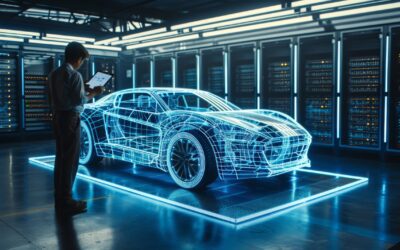Current situation and challenges
The rise of new technologies, consumer preferences, and emerging mobility services are radically transforming the automotive industry. We find ourselves in an exciting era of change, driven by the pursuit of sustainable digital mobility.
Urban mobility is shifting from private car use to the concept of smart cities, where shared smart transport infrastructures for people and goods include private vehicles, bicycles, and public transit. This industry transformation requires the digital mobility value chain to capitalise on the latest innovations in software and electronics.
Artificial Intelligence (AI), the Internet of Things (IoT), sensor systems, robotics, and mobility services are paving the way, albeit with formidable challenges, towards a technological shift to new business models where the entire mobility ecosystem must collaborate for the evolution of transport services and features. Coordinating different means of transport for efficient door-to-door mobility is essential, as is fostering fully automated and autonomous driving, where software implements new features, capabilities, and vehicle performance enhancements.
Hardware components in vehicles are becoming more powerful and efficient, yet more challenging to manage. Concurrently, the complexity of software functions is growing exponentially, and vehicles are increasingly becoming an “Internet node on wheels.”

Current connectivity ecosystem among vehicles, infrastructures, and public road users. Source: FutureBride Analysis
Enabling technologies
In future mobility scenarios, vehicles will exchange a staggering amount of data with their environment, such as other vehicles, pedestrians’ handheld devices, and surrounding infrastructures like traffic lights, overhead cameras, or even with manned and unmanned aerial platforms.
It is evident that traditional mechanics must be complemented with hardware devices that allow for a seamless and agile data flow, with minimal latency (no more than 50 milliseconds), capable of maintaining its characteristics even in low or degraded connectivity situations. Vehicles will be self-aware and aware of their surroundings, capable of independently processing the vast amount of information being transmitted and received. Front and rear cameras, radar, and lidar (light detection and ranging) devices for detecting and avoiding obstacles and surrounding traffic are now common in many vehicles currently on the market. This remarkable hardware is matched by powerful management software with the most sophisticated artificial intelligence and image identification algorithms (Computer Vision) to turn vehicles into true digital platforms, enabling them to perform safe driving and even carry out evasive manoeuvres to avoid situations that put occupants at risk, such as unexpected lane changes, accelerations, or braking.
When a vehicle is autonomous, this implies that it can react independently, making decisions based on perceived information. It must also filter information and process only data that adds value in its data stream; the rest should be discarded and not included in its internal database. Finally, it should also be able to transmit useful and quality information to other ground and aerial platforms. It involves continuous interaction with the environment, extensively employing the V2V (Vehicle to Vehicle) and V2X (Vehicle to Everything) communication concept. For this, enabling technologies like 5G will be pivotal for the definitive roll-out of autonomous vehicles and traffic management in smart cities.
Moreover, the significance of cybersecurity in communications cannot be overlooked. Efforts will be made to ensure all links and data flow are fortified with a cyber protection layer against malicious attacks, attempts at usurping key user and entity information, and the deployment of deliberately false data. The traceability of information flow secured by blockchain is also emerging as significant added value.
Ongoing developments: towards predictive digital twin technology
At CT, we are engaged in significant urban mobility projects. One such initiative is the ECOMOBILITY KDT-JU project, involving 44 companies from 9 European countries, funded by the European Commission, where CT is responsible for developing a traffic manager for smart cities. With hardware technology and telecommunications devices, image capture, and digital maps generated by our partners, we are able to develop a predictive digital twin that informs us in real-time not only about the current traffic conditions in the city but also about likely future occurrences. Predictive ability will be crucial, going beyond mere data capture and display.
With current traffic data, we can establish trends about its evolution and thereby inform all stakeholders so that they can take the most effective and efficient actions. Everyone can benefit: from drivers, who can receive optimal alternative routes via their GPS devices in case of traffic jams, to city governing bodies, who can be provided with better traffic light synchronisation, display the most useful messages on electronic signage, or suggest the best roadworks or modifications to streets and access points to make traffic flow more smoothly. With the capability to manage both real and synthetic data, we will strengthen our digital twin, ensuring its results and predictions are highly accurate.
Streamlined cities and less pollution are among the many benefits
As we have seen, ecomobility presents significant challenges, but also a great opportunity to deploy the best digital technology for managing the autonomous capabilities of vehicles, integrated into current traffic management. This is an opportunity to make cities more agile, less congested, and where local transport and delivery services can operate more smoothly.
Additional benefits include a significant reduction in polluting emissions due to smoother traffic and promoting the roll-out of clean electric vehicles, decreased travel times between origin and destination, and optimised vehicle usage with shared platform business models.
The enabling technologies available to us for making this impressive leap include: IoT, sensor technology, predictive digital twins, and artificial intelligence. With these, our task will be to integrate all disciplines so that there is a seamless flow of information between vehicles and their environment, ensuring that they operate as if they were a single entity. It’s a complex mission, but we will drive together towards sustainable digital mobility.


